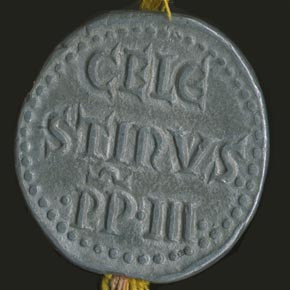
Celestinus III. Giacinto Bobone (1106-1198). Pont. Max. (1191-1198)
Papal Bull addressed to the Chapter of Saint Peter in Mainz. Rome: March 29, 1197.
In general, papal documents designed to introduce legislation have been known under different names depending on their specific function. "Constitutions" are decisions addressed to all the faithful on some matter of faith or discipline; "encyclicals" are letters to all the bishops of Christendom; "decrees" are statements on areas affecting the welfare of the Church; "decretals" are papal letters addressing a particular question and acting as a precedent in order to solve analogous cases in the future; "rescripts" are written as a response to a particular petition, normally in the form of the granting of a privilege. However, all these, until the fifteenth century, share the common denominator of having been issued by the papal chancery in the form of bulls, a term referring to the lead seals known in Latin as bullae that hung from silk threads.
This papal bull, issued by Celestinus III on the 29th of March 1197, was written in Latin on parchment, as it was usually done, and in what paleographers denominate Papal Documentary Script (Littera Documentaria Pontificalis).This handwriting was practiced by scribes of the Papal Curia from the second quarter of the twelfth century onwards. By the eleventh century the Caroline Minuscule (Littera Minuscula Carolina), originally introduced at the end of the eighth century, had already extended its influence over the Papal Chancery, causing the birth and development of the Papal Documentary Script (Brown, 1990:120-1).
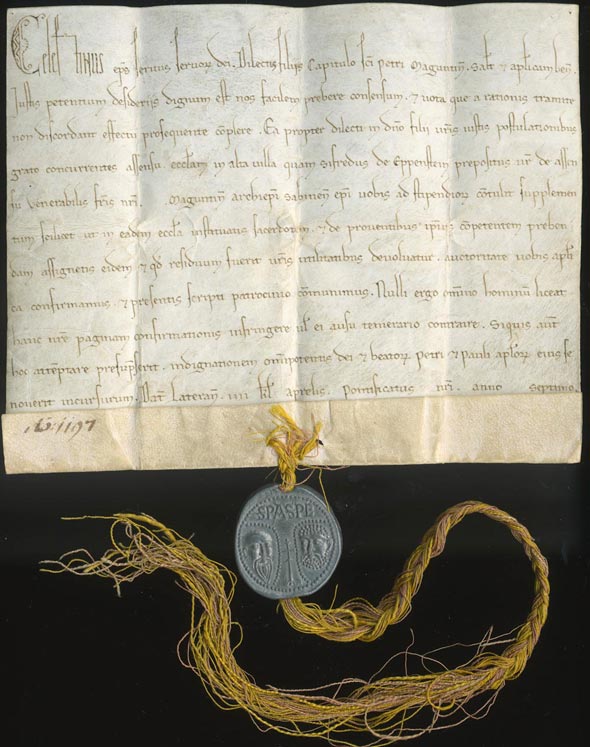
The full transcription of this document is as follows:
Celestinus Ep(iscopu)s servus servor(um) dei. Dilectis filiis Capitulo Sancti Petri Maguntin(i). Sal(u)t(em) et Ap(osto)licam ben(edictionem). | Justis petentium desideriis dignum est nos facilem prebere consensum et vota que a rationis tramite | non discordant effectu prosequente co(m)plere. Ea propter dilecti in d(omi)no filii v(est)ris iustis postulationibus | grato concurrentes assensu. eccl(esi)am in alta villa quam Sifredus de Eppenstein prepositus v(este)r de assen/ su venerabilis fr(at)is n(ost)ri. Maguntin(i) archiep(iscop)i Sabinen(sis) ep(iscop)i vobis ad stipendior(um) co(n)tulit supplemen | tum scilicet ut in eadem eccl(essi)a instituatis sacerdotem et de proventibus ip(s)ius co(m)petentem preben | dam assignetis eidem et q(uo)d residuum fuerit v(est)ris utilitatibus devolvatur auctoritate vobis ap(osto)li | ca confirmamus et presentis scripti patrocinio co(m)munimus. Nulli ergo om(n)ino hominu(m) liceat | hanc n(ost)r(a)e paginam confirmationis infringere v(e)l ei ausu temerario contraire. Si quis aut(em) | hoc atte(m)ptare presu(m)pserit indignationem om(n)ipotentis dei et beator(um) petri et pauli ap(osto)lor(um) eius se | noverit incursurum. Dat(um) Lateran(i) IIII Kal aprelis pontificatus n(ost)ri anno septimo (Würdtwein, 1769: II, 344; Migne, 1844-64: 206, 1207; Ricci, 1937: II, 1868-9).
The bull includes most of the formulaic expressions which were commonly employed by the papal chancery in this type of document. To be precise, these formulae appeared within each of three main sections, which scholars conventionally designate as "initial protocol," "text," and "final protocol" or "eschatocol" (Poole, 1915: 42-50).
The initial protocol of our document includes an intitulatio, which contains the pope's name, Celestinus, and his title Episcopus servus servorum dei ("Bishop Celestinus, servant of the servants of God"). This is followed by the inscriptio, or the names of the individuals to whom the letter is addressed, Dilectis filiis Capitulo Sancti Petri Maguntini ("To his beloved sons of the Chapter of Saint Peter in Mainz"). And next we read the formal salutatio, Salutem et apostolicam benedictionem ("Greetings and apostolic blessing").
The text proper begins with an arenga or preamble, whereby the pope establishes the worthiness of giving consent to the fair wishes of the petitioners (Justis petentium desideriis dignum est nos facilem prebere consensum), particularly when the requests do not stray from the path of reason (et vota que a rationis tramite non discordant). Next is the narratio or description of the case. After addressing again the beloved sons in the Lord (dilecti in domino filii), and restating the need to grant their fair petition (vestris iustis postulationibus grato concurrentes assensu), we are told about the particularities of the request itself. Through a dispositio, or enacting clause, the pope is confirming and supporting an existing practice by using the apostolic authority and the weight of the present document (auctoritate vobis apostolica confirmamus et presentis scripti patrocinio communimus). With the consent of Conrad of Wittelsbach (1120/5-1200), Bishop of Sabina and Archibishop of Mainz (de assensu venerabilis fratis nostri .Maguntini archiepiscopi Sabinensi episcopi), the provost Siegfried von Eppstein (c. 1165-1230) (Sifredus de Eppenstein) had already added a new parish to the Chapter of Mainz (ecclesiam in alta villa ). The extra funding derived from this new church will be used to appoint a priest, employing the remaining funds for other useful purposes (vobis ad stipendiorum contulit supplemen tum scilicet ut in eadem ecclessia instituatis sacerdotem et de proventibus ipsius competentem prebendam assignetis eidem et quod residuum fuerit vestris utilitatibus devolvatur). Finally, we find the customary sanctio, which normally consists of a prohibitive clause, "To no one, therefore, it is permitted to violate the page of our confirmation or to oppose by daring boldness" (Nulli ergo omnino hominum liceat hanc nostrae paginam confirmationis infringere vel ei ausu temerario contraire), and of a penal clause or curse, "If anyone should consider to attempt it, let him know that he will fall into the indignation of almighty God and the blessed apostles Peter and Paul" (Si quis autem hoc attemptare presumpserit indignationem omnipotentis dei et beatorum petri et pauli apostolorum eius se noverit incursurum).
The final protocol, or eschatocol, includes the datum or date, "Given at the palace of the Lateran, 4th Kalends of April, in the seventh year of our pontificate"(Datum Laterani IIII Kal aprelis pontificatus nostri anno septimo). Therefore, it should be dated on the 29th of March (four days before the Kalends of April, i.e. April 1st), 1197 (Celestinus III was elected in 1191).
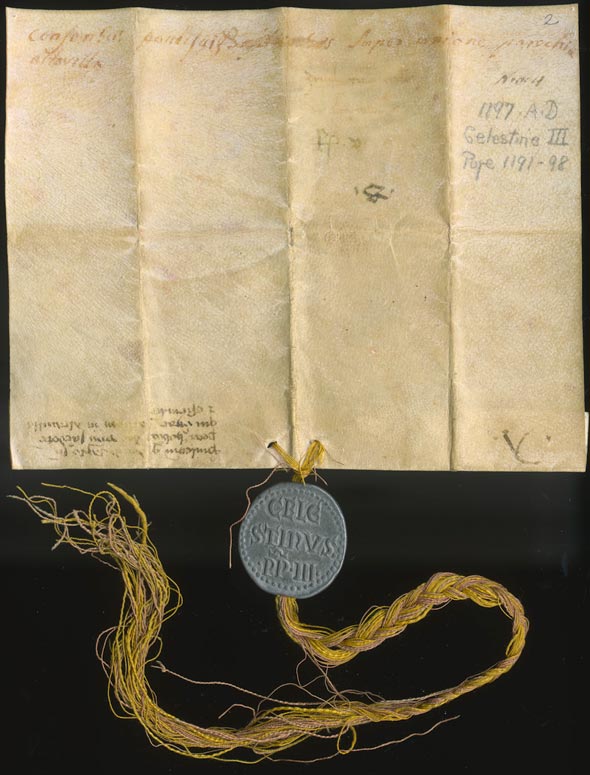
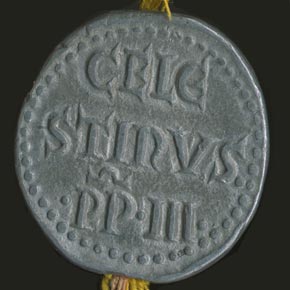
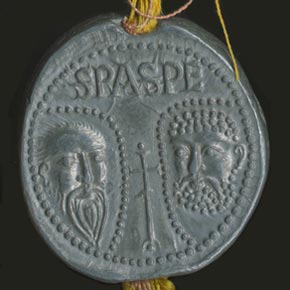
Each pope had a personal seal that he employed throughout his pontificate. The obverse displayed the name of the pope, title and number surrounded by a unique number of dots. The reverse showed the heads of St. Peter and St. Paul also encircled by a unique number of dots. Since forgery of papal bulls was widespread during a great period of the Middle Ages, the Church was obliged to counter-attack with ingenious methods to detect the spurious documents. For instance, in his Summae decreti et decretalium, the Dominican Martinus Polonus argued how the unique number of dots could be used as a test for doubtful bulls.
"Quod false littere percipi possunt in bulla, puncta numerando. Nam vera bulla in circulo ubi sunt apostoli sive capita apostolorum habet 73 puncta. Alius vero circulus in alia parte 75. Alius qui est supra caput Petri habet 25, qui sunt in fronte beati Petri. Sed in fronte beati Pauli non sunt nisi 24. Et in barba beati Petri 28."
Indeed, a forgery in a bull can be detected by counting its points. For a true bull has 73 points in the circle where the apostles are or where their heads are. On the other side, the circle has 75. Another circle above the head of St. Peter has 25 points, which are around the forehead of St. Peter. But around the forehead of St. Paul there are only 24, and in the beard of St. Peter, 28 (Delisle, 1857: n.1, 48; Clemens & Graham, 2007: 233).
This blog entry was originally contributed by Pablo Alvarez, Curator of Rare Books at the University of Rochester from 2003 to 2010.
Selected Bibliography
Brown, Michelle P. A Guide to Western Historical Scripts from Antiquity to 1600. Toronto: University of Toronto Press, 1990.
Clemens, Raymond & Timothy Graham. Introduction to Manuscript Studies. Ithaca & London: Cornell University Press, 2007.
Delisle, Léopold. Memoire sur les actes d'Innocent III, suivi de l’itinéraire de ce pontife. Paris: August Durand, 1857.
Migne, Jacques Paul. Patrologiae cursus completus seu bibliotheca universalis integra: Series latina. 221 vols. Paris: 1844-64. Supplementum 1- Paris:, 1958-.
Poole, Reginald Lane. Lectures on the History of the Papal Chancery down to the Time of Innocent III. Cambridge: Cambridge University Press, 1915.
Ricci, Seymour de. Census of Medieval and Renaissance Manuscripts in the United States and Canada. 4 vols. New York: H. W. Wilson, 1935-40.
Würdtwein, Stefan Alexander. Dioecesis Moguntina in archidiaconatus distincta et commentationibus diplomaticis illustrata. 3 vols. Mannheim, 1769-1777.

